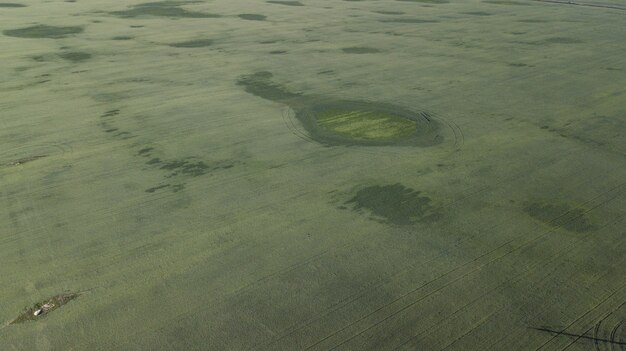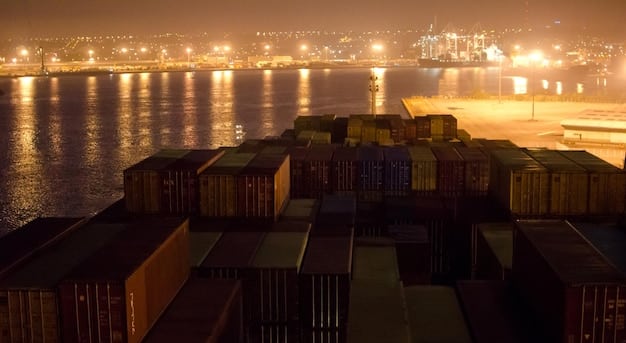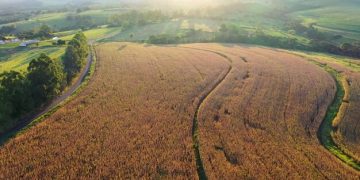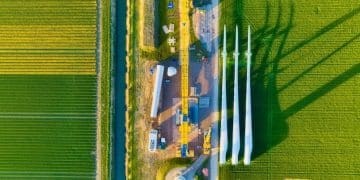Future of Farming: Climate Change & Food Prices in 5 Years

The nexus of climate change and agricultural systems portends significant shifts in global food prices over the next five years, driven by supply chain disruptions, altered growing seasons, and increased demand for resilient farming practices that will inevitably impact consumer costs.
As we stand on the precipice of an increasingly uncertain climate future, one question looms large: how will these environmental shifts impact our dinner plates? The intricate relationship between agriculture, climate change, and global economics suggests that the answer is complex, with profound implications for the cost and availability of food. Understanding The Future of Farming: How Will Climate Change Affect Food Prices in the Next 5 Years? requires a deep dive into environmental science, global supply chains, and consumer markets.
The Unfolding Landscape of Climate Change on Agriculture
Climate change is not a distant threat but a present reality, reshaping agricultural landscapes worldwide. Its multifaceted impacts are already being felt, from altered precipitation patterns to increased frequency of extreme weather events. These changes directly influence crop yields, livestock health, and the overall productivity of farming systems, setting the stage for potential shifts in food prices.
Altered Weather Patterns and Crop Yields
One of the most immediate effects of climate change on agriculture is the disruption of established weather patterns. Regions historically conducive to certain crops are experiencing shifts, leading to unpredictable growing seasons and fluctuating yields. This unpredictability makes it harder for farmers to plan, often resulting in either surplus or scarcity, both of which can distort market prices.
- Increased Temperatures: Higher average temperatures can accelerate plant growth cycles, but also increase water stress and reduce pollination effectiveness for many staple crops.
- Variable Precipitation: Shifts from consistent rainfall to more intense, infrequent downpours can lead to both droughts and floods, severely impacting crop establishment and harvesting.
- Extreme Weather Events: Hurricanes, heatwaves, and droughts are becoming more common and intense, capable of wiping out entire harvests and significantly reducing regional food supplies.
The long-term implications are particularly concerning for regions already struggling with food security. As traditional farming methods become less viable, the need for adaptive strategies becomes paramount. The inability to consistently produce sufficient quantities of food due to these environmental pressures directly translates into upward pressure on prices at the consumer level.
Impact on Livestock and Fisheries
Beyond crops, climate change also profoundly affects livestock and fisheries. Rising temperatures can lead to heat stress in animals, reducing productivity in meat and dairy sectors. Changes in ocean temperatures and acidity threaten marine ecosystems, impacting fish stocks and the livelihoods of fishing communities. Declining yields in these sectors contribute to higher prices for protein sources, affecting dietary diversity and affordability for many households.
The interconnectedness of these components means that a disruption in one area often cascades throughout the entire food system. For instance, reduced crop yields can increase feed costs for livestock, which in turn drives up meat prices. These ripple effects are crucial to understanding the future of food economics.
Moreover, soil degradation, fueled by intensive farming practices and exacerbated by climate change, diminishes arable land. This erosion of fertile ground further constrains food production capabilities, pushing up prices as supply struggles to meet demand. The imperative to invest in soil health and sustainable land management is increasingly clear, not just for environmental preservation, but for economic stability too.
Supply Chain Vulnerabilities and Market Volatility
The global food system operates through complex and often fragile supply chains. Climate change introduces new points of vulnerability, from farm to fork, that can amplify price fluctuations and create widespread market volatility. Understanding these weak points is critical to anticipating future food price trends.

Transportation and Storage Challenges
Extreme weather events can cripple transportation networks, delaying the delivery of goods and increasing logistical costs. Flooded roads, damaged ports, and disrupted shipping routes mean fresh produce spoils and essential commodities face significant delays. These bottlenecks inevitably translate into higher prices for consumers, as transportation costs rise and product availability decreases.
- Route Disruptions: Key trade routes, especially those dependent on stable weather conditions, are increasingly at risk, forcing longer or more expensive alternatives.
- Infrastructure Damage: Extreme weather can directly damage storage facilities, leading to spoilage and loss of agricultural products before they even reach the market.
- Elevated Insurance Costs: As risks escalate, insurance premiums for agricultural enterprises and supply chain logistics also rise, adding another layer of cost that typically gets passed on to consumers.
Beyond immediate disruptions, the need for more resilient infrastructure, capable of withstanding climate extremes, represents a significant investment. These costs, whether borne by governments or private entities, will likely be reflected in the final prices of food products. The global interconnectedness means that a disruption in one region can have far-reaching effects, impacting food prices thousands of miles away.
Speculation and Market Reactions
Perceived or actual shortages of staple crops, fueled by climate-related events, can trigger speculative trading in commodity markets. This speculation can artificially inflate prices, creating further volatility and making food less affordable. The psychological impact of climate change on market behavior is a powerful, yet often overlooked, factor influencing food prices.
Furthermore, governments and international organizations often intervene in times of crisis, but these interventions can also have unintended consequences, sometimes distorting market signals and impacting long-term price stability. The confluence of physical climate impacts and financial market dynamics creates a complex environment for predicting food price movements.
The unpredictability associated with climate-induced weather events also makes long-term investment in agriculture riskier. Farmers may be hesitant to invest in new technologies or expand operations if future yields are uncertain, potentially limiting future supply and keeping prices elevated.
The Role of Technology and Innovation in Mitigation
While the challenges posed by climate change are formidable, innovation in agricultural technology offers promising avenues for mitigation and adaptation. These advancements, if widely adopted, could help stabilize food production and, consequently, food prices in the face of environmental pressures.
Precision Agriculture and Data Analytics
Precision agriculture uses data analytics, sensors, and GPS technology to optimize farming practices. By providing farmers with real-time information on soil conditions, weather patterns, and crop health, it enables them to make more informed decisions, reducing waste and increasing efficiency. This approach can lead to higher yields with fewer resources, potentially offsetting some of the climate-induced production shortfalls.
- Optimized Resource Use: Targeting water and nutrient application reduces waste and lowers operational costs.
- Early Anomaly Detection: Identifying disease or pest outbreaks early prevents widespread crop loss.
- Enhanced Yield Forecasting: More accurate predictions allow for better planning and market management.
The widespread adoption of precision agriculture, however, requires significant investment and training for farmers. Bridging this gap, especially in developing regions, will be crucial for its broader impact on global food prices. Moreover, the data generated can inform broader policy decisions and risk management strategies across the agricultural sector.
Climate-Resistant Crop Varieties
Biotechnology and genetic engineering are playing a pivotal role in developing crop varieties that are more resilient to extreme weather conditions, pests, and diseases. Drought-resistant corn, salt-tolerant rice, and heat-tolerant wheat are examples of innovations that could help secure food supplies in vulnerable regions.
These new varieties not only ensure more stable yields but can also open up new arable land previously considered unsuitable for cultivation. However, the development and deployment of these crops often involve regulatory hurdles and public acceptance challenges. The pace at which these innovations can be scaled will significantly influence their impact on future food prices. Furthermore, research and development costs associated with these advanced crops can initially be high, which may translate into higher seed prices for farmers, potentially influencing commodity costs.
Furthermore, vertical farming and controlled environment agriculture (CEA) offer solutions for growing crops in urban areas, minimizing land use and environmental exposure. While currently more expensive, advancements in these technologies could make them more economically viable, providing a stable, localized food supply less susceptible to climate fluctuations.
Policy and International Cooperation’s Influence
Addressing the impact of climate change on food prices requires more than just technological solutions; it demands robust policy frameworks and strong international cooperation. These broader initiatives can create an enabling environment for sustainable agriculture and equitable food distribution.
Government Subsidies and Support Programs
Governments can play a crucial role by providing subsidies and support programs that incentivize farmers to adopt climate-resilient practices. This includes financial aid for investing in irrigation systems, sustainable land management, and diversification of crops. Such support can help absorb some of the initial costs of adaptation, preventing them from being fully passed on to consumers.
However, the design and implementation of these policies are critical. Poorly conceived subsidies can distort markets or disproportionately benefit certain agricultural sectors. Effective policies aim to create long-term stability and resilience, ensuring that food production remains viable and affordable for the population.
Additionally, policies related to disaster relief and risk management are becoming increasingly important. Establishing robust insurance schemes for farmers facing climate-related losses can prevent widespread bankruptcies and ensure continued food production.
Global Trade Agreements and Food Security
International cooperation, particularly through trade agreements, can facilitate the movement of food from surplus to deficit regions, helping to stabilize global prices. However, current trade structures can also be vulnerable to climate shocks, and there’s a growing need for agreements that prioritize food security and resilience.
Efforts to reduce trade barriers for climate-resilient agricultural products and to share best practices in sustainable farming are examples of how international collaboration can contribute to price stability. Addressing food waste, both at the production and consumption levels, is another critical area where global partnerships can yield significant benefits, essentially increasing the effective food supply without increasing production costs.
Moreover, global initiatives focused on early warning systems for climate-related agricultural crises can help countries prepare for and mitigate potential food shortages, thus preventing panic buying and speculative price hikes. This proactive approach is essential for maintaining market stability in an increasingly unpredictable world.
Consumer Behavior and Dietary Shifts
The impact of climate change on food prices is not solely determined by supply-side factors; consumer behavior and dietary preferences also play a significant role. Shifts in what people eat and how they acquire food can either exacerbate or alleviate price pressures.
Demand for Sustainable and Resilient Food Systems
As awareness of climate change grows, so does consumer demand for food produced through sustainable and climate-resilient methods. This can drive prices up for such products, reflecting the higher production costs, but it also incentivizes farmers to adopt better practices. The premium placed on sustainably sourced food suggests a growing segment of the population willing to pay more for environmentally conscious choices.
- Local and Seasonal Eating: A shift towards consuming local and seasonal produce can reduce transportation costs and support regional food systems, potentially stabilizing prices by shortening supply chains.
- Plant-Based Diets: Increased adoption of plant-based diets can reduce the demand for resource-intensive animal products, which could help to lower overall food system costs and environmental footprint.
- Reduced Food Waste: Conscious efforts by consumers to reduce food waste can indirectly lower demand, contributing to price stability and resource conservation.
The collective power of consumer choices can influence market trends and investment in sustainable agriculture. Education and advocacy around these issues are vital for fostering widespread behavioral changes that can positively impact food price stability in the long run.
Impact of Income Inequality on Access to Food
Rising food prices disproportionately affect lower-income households, exacerbating existing inequalities. When basic food items become more expensive, these families face difficult choices, sometimes compromising on nutrition or quality. This creates a social imperative for policies that address food accessibility alongside climate adaptation.
Even moderate increases in global food prices, when combined with stagnant wages or economic downturns, can push millions into food insecurity. Understanding how these socio-economic factors interact with climate-induced price shifts is crucial for developing equitable and effective solutions. The future of farming must consider both environmental sustainability and social equity to ensure everyone has access to affordable, nutritious food.
Furthermore, changes in culinary trends, such as the increasing popularity of certain niche ingredients or exotic foods with complex supply chains, can also amplify their price volatility when climate events impact their specific growing regions. This highlights the interconnectedness of global food culture with climate vulnerability.
Projecting Food Prices: What to Expect in 5 Years
Forecasting food prices is inherently challenging due to numerous variables, but considering the accelerating pace of climate change and evolving societal responses, we can identify key trends likely to emerge over the next half-decade. The expectation is not a uniform increase, but rather a pattern of intensified volatility and regional disparities.
Increased Volatility and Regional Disparities
Instead of a steady upward climb, food prices are more likely to exhibit greater volatility. Extreme weather events will trigger sudden price spikes for specific commodities in affected regions, while unaffected areas may see relative stability. This means consumers will experience unpredictable fluctuations, making budgeting and food planning more complex.
- Staple Crop Vulnerabilities: Grains like wheat, rice, and corn, being highly susceptible to weather shifts, are likely to see the most noticeable and frequent price changes.
- Perishable Goods Fluctuations: Fresh fruits and vegetables, with shorter shelf lives and complex supply chains, will also be highly vulnerable to climate disruptions, leading to seasonal price instability.
- Geographic Hotspots: Regions heavily reliant on rain-fed agriculture or coastal communities dependent on fisheries will face more severe price increases and supply challenges compared to those with diversified or controlled agricultural practices.
This increased volatility will necessitate more robust national and international food reserves, as well as improved early warning systems, to mitigate crises. Without such measures, consumers will bear the brunt of these market swings.
Shifts in Production Costs and Consumer Impacts
The cumulative effects of climate change adaptation measures, such as investments in drought-resistant seeds, improved irrigation, and resilient infrastructure, will inevitably add to production costs. These costs, coupled with potential diminished yields, will pressure food prices upwards. Farmers will pay more for inputs, and these increased expenses will be passed along the value chain.
However, the extent to which these costs translate to consumer prices will vary depending on government subsidies, retail competition, and the efficiency of distribution networks. Consumers in developed nations might experience higher, but manageable, price increases for basic goods, perhaps leading to dietary adjustments. In contrast, populations in developing countries with lower disposable incomes could face severe food insecurity.
Furthermore, the energy transition, while crucial for climate mitigation, may also impact food prices. The move towards renewable energy sources and away from fossil fuels can influence the cost of fertilizer production, transportation, and agricultural machinery, all of which are embodied in the final price of food. Balancing these transitions will be key to managing food affordability.
Ultimately, the next five years will be a critical period for observing how global food systems adapt to the accelerating pace of climate change. The changes will demand resilience, innovation, and international cooperation to navigate the complex interplay of environmental shifts and economic realities.
| Key Point | Brief Description |
|---|---|
| 📈 Climate Impact | Altered weather patterns and extreme events directly reduce crop yields and livestock productivity. |
| 🔗 Supply Chain Stress | Disruptions to transportation and storage increase costs and lead to market volatility. |
| 💡 Tech Solutions | Precision agriculture and climate-resilient crops offer mitigation, but require significant investment. |
| 🌍 Policy & Cooperation | Government support and international agreements are critical for stable and equitable food systems. |
Frequently Asked Questions
▼
Climate change will affect crop yields primarily through altered rainfall patterns, increased temperatures leading to heat stress, and more frequent extreme weather events like droughts or floods. These factors can reduce plant growth cycles, hinder pollination, and prevent successful harvests, ultimately leading to lower output for many staple crops.
▼
While technology, such as precision agriculture and climate-resilient crop varieties, offers significant potential for mitigation, it alone may not fully offset price increases. The widespread adoption of these technologies faces challenges like high initial investment, regulatory hurdles, and public acceptance. Furthermore, geopolitical stability and effective policy support are also crucial balancing factors.
▼
Foods highly dependent on specific growing conditions or extensive supply chains are most vulnerable. This includes staple grains like wheat, rice, and corn, which are susceptible to weather shifts, and perishable items such as fresh fruits and vegetables. Meat and dairy products may also see price hikes due to increased feed costs for livestock.
▼
Consumer behavior plays a significant role. Increased demand for sustainable and locally sourced foods can drive market trends and incentivize more resilient farming. Conversely, food waste exacerbates supply issues. Shifting towards plant-based diets can also reduce the demand for resource-intensive animal products, potentially alleviating some price pressures on the broader food system.
▼
While some subtle shifts are already occurring, more significant and noticeable changes in food prices due to climate change are expected within the next five years. This will likely manifest as increased volatility rather than a steady rise, with sudden spikes following extreme weather events and regional disparities becoming more pronounced.
Conclusion
The journey into the future of farming is undeniably intertwined with the unfolding narrative of climate change. Over the next five years, the impact on food prices is expected to be profound, characterized by increased volatility, regional disparities, and upward pressure on costs due to disrupted supply chains, altered agricultural yields, and the necessary, yet costly, transition to more resilient food systems. While the challenges are substantial, the collective efforts of farmers, innovators, policymakers, and consumers hold the key to navigating this complex landscape. By embracing sustainable practices, investing in cutting-edge technologies, fostering robust international cooperation, and making conscious dietary choices, we can build a more secure and equitable food future, even amidst the uncertainties of a changing climate.





